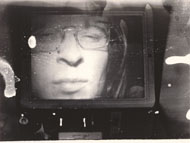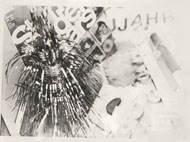 |

 |
 |
Hamburg, 1970
© Sigmar Polke
|
 |
This exhibition presents photographs in the Getty Museum's collection created by Sigmar Polke, who became one of the most influential artists working in post-war Germany. With their juxtaposed images, multiple exposures, extreme close-ups, and under- and over-exposures, these photographs demonstrate the artist's early fascination and experimentation with photography.
Born in 1941, Polke studied from 1961 to 1967 at the Düsseldorf Art Academy where he helped launch an art movement known as Capitalist Realism, which mined popular culture and advertising for its pictorial language. Polke took up photography in the mid-1960s using a handheld 35mm Leica camera. The small, light camera with a silent shutter gave Polke the ability to record "found" still lifes quickly and effortlessly.
Guided by curiosity about the medium's optical and chemical properties, Polke also began to experiment with printing techniques in the darkroom to transform the raw material of his negatives through the alchemy of black-and-white photochemistry.
|
 |

 |
 |
Düsseldorf, 1969
© Sigmar Polke
|
 |
 |
Storefront window displays provided ready-made still lifes for Polke. The absurd juxtapositions and overabundance of items displayed in shop windows provided fodder for the exploration of consumer society. Polke's images offer a catalogue of the types of products that were available to consumers in postwar Germany. They often commented slyly on the nature of taste, as in the pairing here of a cheaply framed painting of flowers with a kitschy planter of ivy.
|
 |
 |

 |
 |
Düsseldorf, 1969
© Sigmar Polke
|
 |
Polke's use of the close-up directs our attention to those details that fascinated him most, such as the arch of the chrome faucets seen here. At times Polke placed two negatives in the enlarger to introduce context and narrative into the final layered image. In this image, Polke used double exposure to embed the two gleaming faucets among shoppers carrying umbrellas as they navigate a flooded street.
|
 |

 |
 |
Düsseldorf, 1969
© Sigmar Polke
|
 |
 |
Polke taught himself to develop his own negatives and enlarge prints. From the beginning, he viewed the darkroom as an arena for exploration. Curiosity about the process of developing prints and seeing images emerge led him to disregard standardized procedures that determine the length of time a print is to remain in each chemical bath and the sequence of those baths.
Polke's impatience with the "rules" of the darkroom often resulted in scratched negatives, under- and overexposures, and prints that further obscured details to create visually disorienting compositions, as in this image of New Year's party favors.
|
 |
 |

 |
 |
Düsseldorf, 1970
© Sigmar Polke
|
 |
Polke's process of experimentation began in the studio, both in terms of the miscellaneous objects he collected and how he combined them to create imaginative, enigmatic scenarios. Some images record works of art in his studio. Others record still lifes he discovered, or created in his studio.
Here Polke cast wooden and plastic animals into a basin of milky water, transforming these ordinary objects into a collage from life.
|
 |

 |
 |
Geneva, 1970
© Sigmar Polke
|
 |
 |
Polke achieved a complicated layering of imagery in his early paintings by applying acrylic or oil to patterned fabrics rather than canvas, appropriating his subject matter from photomechanically produced sources, or enlarging mistakes he found in printed matter. His photographs reached a similar level of complexity when he combined both negatives and positives with images that had both vertical and horizontal orientations.
The resulting collage-like compositions take advantage of under- and overexposure and negative and positive printing to create enigmatic narratives. In the image seen here, the combination of gauzy curtains, the outline of windows, the silhouette of a hand, and a bowed figure provide clues to an ominous mystery that remains just beyond our ability to decipher.
The exhibition is located at the Getty Center, Museum, Center for Photographs, on the Terrace level (L2) of the West Pavilion.
|
 |